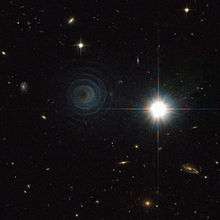IRAS 23166+1655
| Reflection nebula | |
|---|---|
| Protoplanetary nebula | |
 Hubble Space Telescope image of IRAS 23166+1655, taken in the near-infrared. The bright object to the right is a star much closer to Earth. It was used as a guide star for adaptive optics corrections that allowed the Keck II telescope to resolve the LL Pegasi binary pair.[1] | |
| Observation data: epoch | |
| Right ascension | 23h 19m 12s |
| Declination | +17° 11′ 35″ |
IRAS 23166+1655 is thought to be a preplanetary nebula surrounding LL Pegasi (AFGL 3068), a binary system that includes an extreme carbon star. The pair is hidden by the dust cloud ejected from the carbon star and is only visible in infrared light.[1]
The nebula displays an unusual spiral shape. The shape is thought to be formed through the interaction between the stellar companion and the carbon star, as has been seen in other binary systems, although not with such a precise geometric form.[2] The distance between spiral layers is consistent with estimates of the pair's orbital period based on their apparent angular separation. Its position is RA 23 19 12, Dec +17 11 35.[3] Some say that, due to the regular appearance of spiral arms, the orbital period between LL Pegasi A (IRAS 23166+1655 A) and LL Pegasi B (IRAS 23166+1655 B) have an orbital period of c. 800 years.
References
- 1 2 A Binary-Induced Pinwheel Outflow from the Extreme Carbon Star, AFGL 3068, M. Morris, et al.
- ↑ Hubble Spies an Amazing Cosmic Spiral. Universe Today. September 6, 2010
- ↑ "Online Astronomy eText: Assorted Recent Astronomy Pictures". www.cseligman.com. Retrieved 3 February 2016.
External links
- An Extraordinary Celestial Spiral
- Celestial spiral goes viral
- Hubble Spots Ghostly Space Spiral — discovery.com
- Hubble Spots Ghostly Space Spiral — disclose.tv
- An Extraordinary Spiral from LL Pegasi, APOD